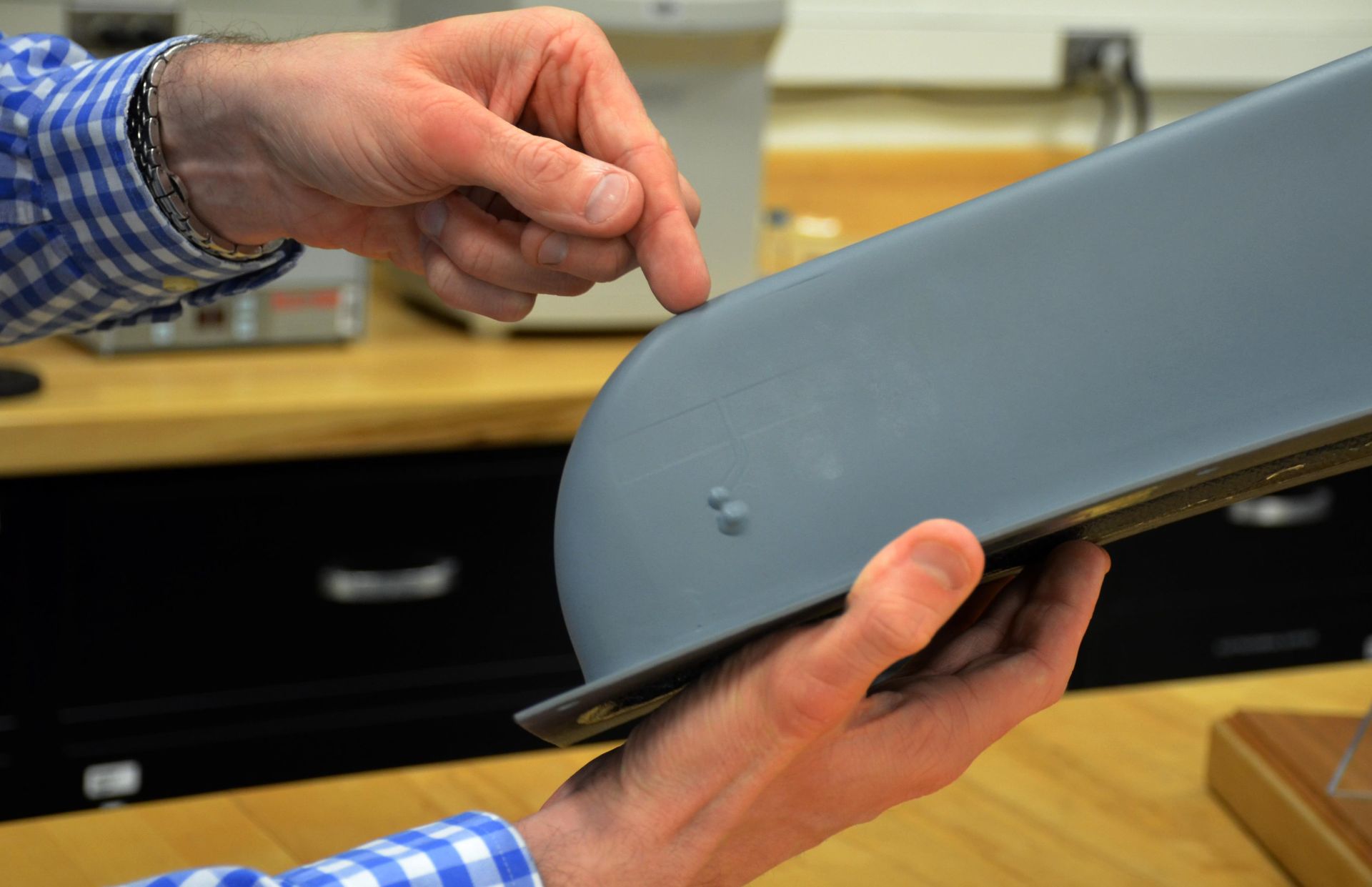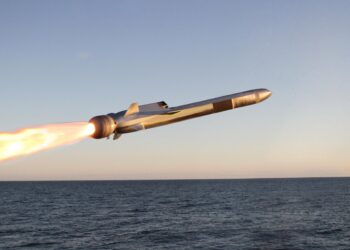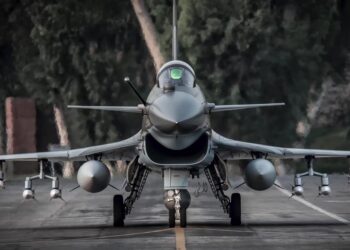WRIGHT-PATTERSON AFB, Ohio — It’s a materials scientist’s dream, but as some experts say, an engineer’s nightmare. For scientists and engineers at the Air Force Research Laboratory’s Materials and Manufacturing Directorate, additive manufacturing, also known as 3-D printing, can be a powerful tool for rapid innovation.
Ultimately, it’s a new way of looking at manufacturing across the materials spectrum and an area with challenges and opportunities that the Air Force is meticulously exploring.
“Additive manufacturing is a huge opportunity for us,” said Dr. Jonathan Miller, a materials scientist and the additive manufacturing lead for the directorate. “It allows us to manufacture unique form factors; it provides the opportunity to add functionality and capability to structures that already exist. Essentially, it allows us to redefine manufacturing.”
Traditional manufacturing methods developed during the times of the Industrial Revolution, when machines began to overtake the human hand for mass production. Many processes required material to be molded or milled away from a larger form to produce a specific design.
Additive manufacturing, by contrast, is defined by ASTM International as the process of joining materials together, layer by layer, based on 3-D model data. It increases design possibilities, enhances the speed of innovation and offers an alternative for creating shapes closer to what an engineer might need, with fewer constraints.
“The biggest problem with conventional manufacturing processes is time,” Miller said. “Manufacturing is an iterative process, and you never get a part ‘just right’ on the first try. You spend time creating the tools to manufacture a complex part and then spend more time when you realize an initial design needs to be modified. Additive manufacturing offers lower cost tooling and lower lead times. The early mistakes don’t hurt you as badly.”
Early days
Though additive manufacturing is receiving a lot of industry interest as of late, it is not new to AFRL. Research into this manufacturing capability for the Air Force started at the same time the concept of rapid prototyping emerged in industry back in the 1980s.
Rapid prototyping was based on the premise that if an engineer had an idea and wanted to make a shape, they could visit a shop and ‘print’ the object, usually out of plastic by a printer.
“The focus at this time was on creating functional prototypes, or objects that resembled a desired part, but the materials lacked the strength for even minimal use,” Miller said.
Early additive processing used light to chemically react to specific regions in a volume of gel to build rigid, plastic parts. The technology further evolved to include fused filament modeling, wherein fibers of plastic thread were melted and joined together to form a new object. Additional powder-based processes made use of plastic flakes that were melted by a laser into a shape.
In the early 1990s, scientists learned that similar additive manufacturing processes could be used for generating metal objects. However, the technology at the time resulted in crude, large parts with poor surfaces. It wasn’t until the late 2000s that laser technology matured sufficient to truly move forward in this domain.
“This spurred the additive revolution pursued today by the entire aerospace industry,” Miller said.
Shift to production parts
While more affordable lasers and metal powder processes were helping scientists make better metal products, the ‘glue gun’ route to additive manufacturing of plastics became much cheaper. Small, inexpensive 3-D printing machines began to turn up in garages and schools, to the amateur engineers delight.
“Collectively, these became a new way of thinking about how to make stuff,” Miller said.
As additive manufacturing thinking evolved from being a way to develop prototypes to a method for actual production, the benefits and applications for the Air Force grew enormously, along with the potential for it to do even more. The manufacturing of customized parts and unique, complex geometric shapes at low production quantities can help maintain an aging aircraft fleet. Custom tools, engine components and lightweight parts can enable better maintenance and aircraft longevity.
“Additive manufacturing can address a multitude of challenges for us, and there is a big pull to implement these processes from the logistics community,” Miller said. “The fleet is aging, and replacement parts for planes built 30 years ago often no longer exist. Rapid production of a small number of hard-to-find parts is extremely valuable.”
However, the need to develop consistent, quality materials for additive manufacturing still remains a challenge that AFRL researchers are working diligently to address. Engineers need to have full confidence in additive manufactured part alternatives as they implement them as replacements in aging fleets or as system-level enablers in new weapon systems.
“There are limits as to how the Air Force can use this technology and for what applications it will work best,” said Miller. “That research is the basis of our work here.”
Extension to functional applications
As additive manufacturing has matured over the past few decades, the field has broadened beyond plastic and metal parts.
Dr. Dan Berrigan, the additive lead for functional materials at the directorate, is exploring ways to use additive manufacturing processes to embed functionality into structure, such as by adding electronic circuitry or antennas on non-traditional surfaces. As the demand for flexible devices such as activity trackers and performance monitors increases, so does a need to power these sources organically.
“Additive processes enable us to deposit electronic devices in arbitrary shapes or in flexible, soft form factors,” Berrigan said. “We are looking at different ways to make a circuit that can enable them to bend or adhere to new surfaces or geometries, such as on a dome or patch. Essentially, we are looking at ways to add capabilities to surfaces that already exist.”
Conventional circuit fabrication requires the lamination of a series of conductive and insulating layers in a patterned fashion, resulting in a rigid circuit board. The electronic properties for these circuits are known and understood, and engineers are able to ensure that the circuit can conduct as intended based on these known concepts.
For 3-D printed electronics, a conductive material is divided up into millions of small pieces and suspended in a liquid that is then dispensed from a printer, explained Berrigan. After printing, those individual conductive pieces must maintain contact to enable electrons to move through a circuit and create power.
“The demand here is for low-cost, flexible electronic devices, and these direct write, additive processes give the community design capabilities that we cannot achieve otherwise,” Berrigan said.
Additive challenges and future potential
Despite years of development and research into additive manufacturing processes, there are a number of implementation challenges that AFRL researchers need to address in order to enable greater Air Force benefit from the technology, both now and in the future.
“Fundamentally, it comes down to a materials processing problem,” Berrigan said.
The lack of standardized production processes, quality assurance methods, significant material variability and reduced material performance are just some of the factors AFRL researchers need to overcome. Depending on the application, material performance can be related to the strength of a part. For example, the electronic properties of an additive manufactured circuit may be worse than those of ones traditionally manufactured.
“Understanding the safety, reliability and durability of a part is critical for an aircraft. We know this for parts made through other processes, but we don’t know this yet for additive,” Berrigan said.
Another issue centers on basic materials compatibility.
“There are a lot of different interfaces in additive manufacturing, and ensuring that materials adhere to one another or that a part can support a certain stress or withstand a certain temperature—these are all challenges we need to address,” Miller said.
The long-term goal, according to Berrigan, is for additive manufacturing to become a well-understood tool in an engineer’s toolbox, so that unique components can be design-integrated into a system. It’s difficult to go back in a system already built, he said, but additive manufacturing provides the opportunities to build in greater potential at the start.
“The long-term vision is to have functional and structural additive manufacturing to work more cohesively from the start. Rethinking systems-level design to incorporate functionality such as electrical wiring, sensors or antennas is a potential that additive can help us address,” he said. “When you build something by layer, why not introduce channels for sensors, cooling or other functions?”










